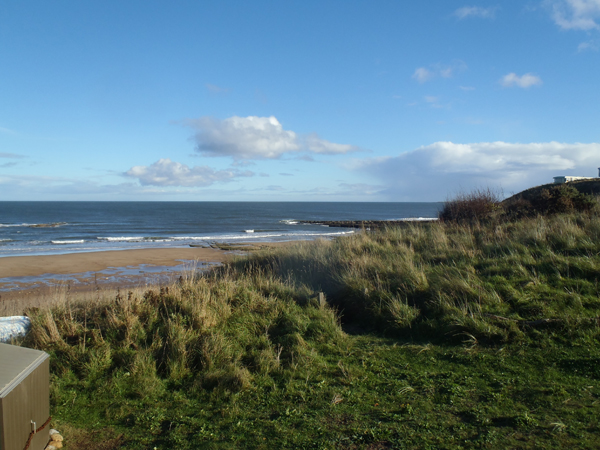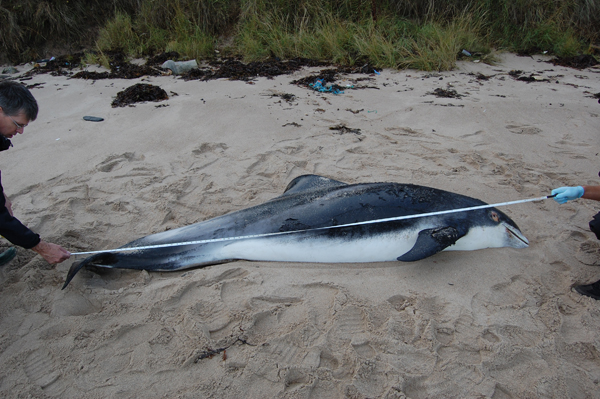On Tuesday morning 22 October we received a message about a dead white-beaked dolphin (Lagenorhynchus albirostris) found on a beach by Alnmouth, Northumberland. The message came from the UK Cetacean Strandings Investigation Programme (http://ukstrandings.org/) that monitors the UK hotline for stranded cetaceans. We participate in this work by responding to strandings that occur locally in Northumberland. After checking the exact location with those that had reported the stranding we (myself, Simon Laing, Dove Marine Lab intern and Paul Dees, Stage 3 Marine Biology student) set off in the school van with a stretcher, wheelbarrow and basic sampling kit with the intention of retrieving the whole animal. The plan was to bring the dolphin and store it in the freezer room at the Dove Marine Laboratory for a full dissection at a later date. We reached the site after an hour drive and found the animal on the beach just below the high tide mark. It was not as fresh as we had hoped and interviews with locals at the nearby caravan park told us that the animal had stranded on Saturday.
 The dolphin was a 2.6m female and we soon realised that we would not be able to move her from the beach along the narrow steep access path to the van. In fact the three of us were barely able to move her at all and struggled to drag her up above the high tide mark. We were not able to weigh her but she was likely weighing 200+ kg. The size and tooth wear told us that this was a mature older female. We extracted teeth for aging and cut out skin, blubber and muscle samples for genetic, stable isotope and contaminant analyses. We also photographed the animal including pictures of the dorsal fin that we will use to match against existing catalogues of known white-beaked dolphins in the North Sea. It was by now late afternoon and we decided to leave the animal and return the next day for more comprehensive sampling.
The dolphin was a 2.6m female and we soon realised that we would not be able to move her from the beach along the narrow steep access path to the van. In fact the three of us were barely able to move her at all and struggled to drag her up above the high tide mark. We were not able to weigh her but she was likely weighing 200+ kg. The size and tooth wear told us that this was a mature older female. We extracted teeth for aging and cut out skin, blubber and muscle samples for genetic, stable isotope and contaminant analyses. We also photographed the animal including pictures of the dorsal fin that we will use to match against existing catalogues of known white-beaked dolphins in the North Sea. It was by now late afternoon and we decided to leave the animal and return the next day for more comprehensive sampling.
We returned on Wednesday equipped with scalpels, knives, saw and various sampling bags. We took samples from kidney and liver (for heavy metal analysis), blood (for blood chemistry) and we also took uterus and ovaries (for reproductive biology – she was not obviously pregnant) and stomach (for diet analysis). We then took the whole head for studies of the sound production organs and one of the flippers that we will clean and eventually have on display together with the skull.
The white-beaked dolphin is endemic to the Atlantic Ocean and regarded as a continental shelf species with an abundance of about 10,000 in the North Sea. It is one of the larger dolphins (1.1-1.2m at birth growing to around 2.5-3m and 200-300kg). It is characterized by its short thick white coloured beak, white or pale grey markings on the flanks, counter-shading and curved dorsal fin. They become sexually mature around 10 years of age and the lifespan is about 40 years. They feed on fish and cephalopods. There is little information about the species social structure and group size is 1-20. For more information about the abundance and distribution of white-beaked dolphins and other cetaceans in European waters please see the following recent publication: Hammond PS, Macleod K, Berggren P, et al. 2013. Cetacean abundance and distribution in European Atlantic shelf waters to inform conservation and management. Biological Conservation. 164, 107-122. Read abstract and download paper here: http://www.ncl.ac.uk/marine/research/publication/192635
You can also watch white-beaked dolphin swimming underwater filmed by Ben Burville off the Northumberland coast here: http://www.youtube.com/watch?v=wmDC2Cj_ROk
For more information please contact: Dr Per Berggren (per.berggren@ncl.ac.uk)



